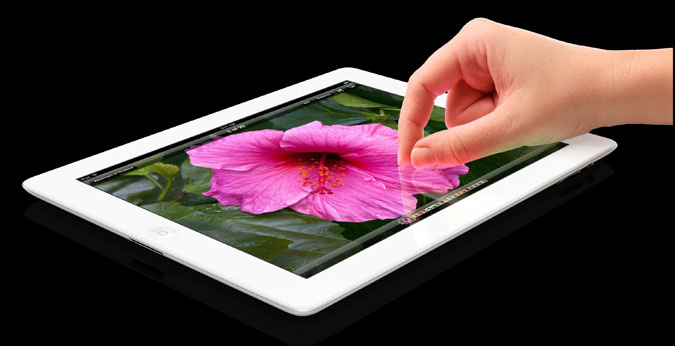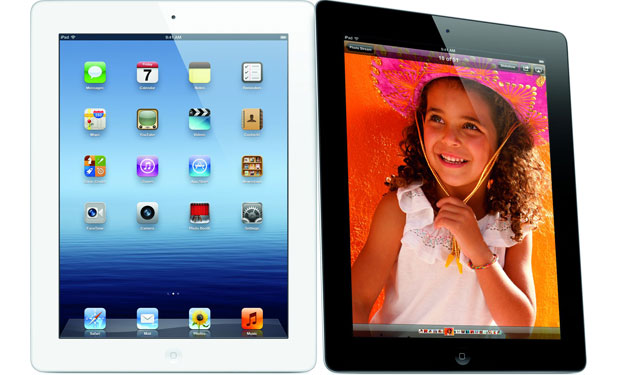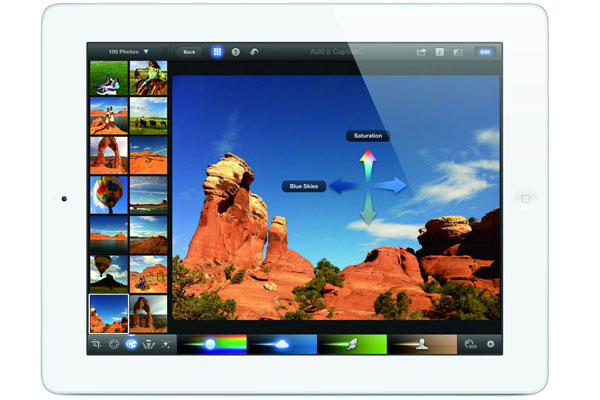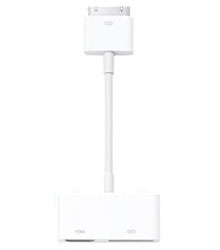
Few gadgets have achieved the meteoric rise to iconic status as quickly as the iPad, and it certainly seems like more than a fair share of pop culture's most coveted gear has originated in Cupertino, California. But as wild as the success has been, they managed to make the product even better in its second generation, notably with the introduction of twin cameras. Fanboy speculation runs hotter on Apple gear than most, and all of the buzz about a true HD screen in 2011 was ultimately unfounded.
Well, another year has passed and Apple has not merely reached that formerly elusive video threshold, they have exceeded expectations with the addition of their drool-worthy Retina display on the new iPad. Yes, Apple is simply calling this "the new iPad," not "iPad 3," but it is indeed the third generation of their now-ubiquitous tablet. The new screen is the largest iteration of the Retina display yet, the company's trademark high-res LCD which debuted on the iPhone 4, but now with a better-than-Full-HD-1080p resolution of 2048x1536 pixels. That factors out to over 3.1 million pixels, four times the count in the iPad 2 in the same 9.7-inch screen size and--as Apple seems only too keen to point out, and who can blame them--that's one million more pixels than we'll find in an HDTV. They also like to call it "the best display ever on a mobile device," and I'm not going to disagree.
At 264 pixels-per-inch (double that of last year), they're so dense that the typical human eyeball can't discern them individually when the new iPad is held at a normal distance, hence the Retina moniker. And now video can be played back in true 1080p for the first time on an iPad.

Packing that many tiny pixels into the same finite space brought inherent challenges, so Apple employed Super High Aperture technology that elevates the red/green/blue sub-pixels above the signal lines that tell it when and how much to light up. This might be one of the reasons that this new model is three-hundredths-of-an-inch thicker and slightly heavier (by less than two ounces). But the welcome result is a clearer, sharper, brighter image. At the same time, color saturation is now 44 percent greater than last year's.
What's Inside?
The new A5X processor is enhanced with quad-core graphics and together they have a much harder job to do, driving four times the pixels of their predecessor. And yet their efficiency combined with an upgraded battery allow operating life to hold fast at an impressive but attainable ten hours off a long, slow full charge, despite the demands of the new screen and the stepped-up connectivity options.
The internal capacity choices remain constant over the history of the iPad, with handy 64-gigabyte (as reviewed), middle-of-the-road 32GB and entry-level 16GB configurations. All models once again embrace Wi-Fi, while the premium "Wi-Fi + Cellular" line, with our choice of AT&T or Verizon networks, supports up to 4G LTE systems here in the U.S.. This offers a nice speed boost from the iPad 2's 3G data speeds. The new iPad can serve as a personal hotspot for up to five devices, over USB or wirelessly via Wi-Fi or Bluetooth.
Side-by-side with the iPad 2, I clocked the new iPad at about a-second-and-a-half slower to power up and to power down, which I found surprising. The speed with which individual apps launched was a mixed bag, some quicker on the 2012 model and some slower and some about the same. The new iPad arrives loaded up with iOS 5.1, and an update was already available when we began our review. iOS 5 allows us to update wirelessly, away from the computer, with just the new iPad and an internet connection. The transitions between the various screens within different apps are fast, fluid and downright snazzy, bringing an extra level of enjoyment to our use of the device.

The new iPad also takes full advantage of the latest iCloud technology, with five free gigabytes of online storage and backup. (iTunes Store purchases do not count against this free limit, a nifty perk.) This remote storage option can hold copies of our photos, apps, contacts, calendars and more, and can push them wirelessly to the iPad, and a linked iPhone, and the computer. I was able to link to my existing account via the device itself without the need to plug into the computer, and immediately grab content from the iCloud to play locally.
Of course, this is not a perfect system: I had purchased Avatar from iTunes for review back in December but I was informed that neither the HD version nor the bundled SD file would be available via the iCloud, so this movie at least needed to be loaded via a wired connection to the computer where my iTunes Library resides. Not sure why this is the case, as plenty of newer and older purchases are all just a click of the "Download" button away, at no additional charge, anywhere I have a wireless signal. The new iPad also has a weird tendency to quit out of iTunes unexpectedly.
When buying a new song or an app via the iTunes Store on the computer, I instantaneously received the message on the new iPad that by turning on Automatic Downloads I could receive that same file on the device without needing to physically sync. Other doodads in iOS5 allow me to Find My iPad with a map, a sound, a display or a message (sadly, I have needed this help on at least one occasion) and a dedicated Dictation button that enables speech-to-text in any app that uses a keyboard.
Pixels Worth a Thousand Words
Don't judge me: Once initial setup was completed and the home screen first appeared, I almost wept. I could see an irrefutable leap forward in sharpness and clarity even in the standard water-on-a-foggy-day wallpaper, as if this was the portal to a whole other virtual world, and I kept expecting someone or something to emerge from the depths. If only I could shrink down to 9.7 inches at my widest point and climb inside....
I queued up a variety of HD video content, movie rentals and purchases as well as video captured on the device itself. Sooner rather than later we'll need to change our iTunes account from the default 720p Download to 1080p Download setting, in light of Apple's recent embrace of the full resolution HDTV standard. Surprisingly (and thankfully), the 1080p files tend to be not much larger than 720p: I took this opportunity to finally buy UP in HD, and noted that the file was 3.68 GB in 1080p versus 3.276 for the same movie in 720p, both with a Dolby Digital 5.1 soundtrack. I tried to swap out my Avatar for 1080p at the same time, but discovered that 720p is as good as that one gets in iTunes.

The image on all of my HD demos was routinely crisp, especially credits and title text that really tends to pop at this stunning resolution. Planet Earth, that high-def darling, flaunted the tiny specks of flocking birds or migrating cattle, even their teensy legs as seen from high above readily apparent whether zoomed in or out. UP showed that same precision in Carl's skin, the dogs' hair and assorted grasses, as I've come to expect from repeat viewings of the Blu-ray, now in a two-fisted form factor.
The Apple Digital AV Adapter I had been using to connect the iPad 2 to the TV is unsupported by the new iPad, but thankfully Apple sent along the second-generation dongle with the review sample. To help clarify, last year's adapter arrived in a plastic bag and was model number MC953ZM/A. This year's model is MD098ZM/A and comes in a cardboard box. The plug that connects to the iPad's 30-pin port is now slimmer, with a locking mechanism, while the dongle that adds the HDMI and 30-pin pass-though ports is now squatter.
Over this hard HDMI connection, my Samsung plasma noted the incoming signal as 1920x1080 @60Hz, with a pleasingly detailed image and remarkably few compression artifacts. The new iPad apparently upconverts 720p content like Avatar internally, outputting the video at these same specs as well.

Pushing the video wirelessly to the previous generation of Apple TV via AirPlay ultimately delivered a 1280x720@60 signal to my display, and of course the image was softer, with a more pronounced ringing effect. The latest Apple TV will perform this trick at 1080p. AirPlay streaming at 720p offers a superior video experience compared to DVD, especially in the stability of fine details and textures, but Blu-ray need not watch nervously over its shoulder. I can't say much for the new iPad's onboard audio, still delivered from a tiny edge-mounted speaker array, but movie soundtracks in Dolby Digital 5.1 via AirPlay offer an outstanding experience, with discrete cues across the entire multichannel soundstage.
The improvement in video performance of the new iPad over the iPad 2 is simply monumental, an emphatic conclusion that I later confirmed with a couple of learned civilians. The revelation is much like another recent Apple-related experience I had, inspecting a repaired second-generation iPod touch just back from the shop, this after almost two years of staring at the vaguely similar but vastly more sophisticated iPhone 4. No contest.
Lest We Forget...
I do have the unenviable responsibility to report that omnipresent Flash video is still unsupported by the iPad family, an omission which will surely lead to ongoing frustration as we visit websites across the internet with embedded video that simply will not display on this device. With Adobe pulling the plug on Flash for mobile devices, we expect more sites will migrate to HTML 5, but until then you may (will) have issues viewing some multimedia content online.
There aren't any more cameras on this iPad (just the standard two), but both stills and video are better than ever. The outward-facing iSight camera offers not-too-shabby-for-a-tablet five-megapixel quality with auto-focus and tap-to-focus and 1080p video recording at up to 30 frames per second with video stabilization. The five-element lens offers a larger ƒ/2.4 aperture and a hybrid infrared filter for sharper images with more accurate colors. The backside illumination sensor adjusts for a variety of lighting environments, and face detection automatically balances the focus and exposure across as many as ten different faces in a single shot.
The 16:9 1080p HD video capture is outstanding, a marked improvement over last year's 720p capabilities, pulling out remarkable picture information even from blurry portions of the frame. So too is still photography, with a lush precision to images as digital noise is now drastically reduced. The user-facing FaceTime camera again offers VGA-quality still photos and 30fps video with optional photo and video geo-tagging.
Turn-Ons:
Turn-Offs:
Final Thoughts:
Anyone waiting for "The iPad HD" as it was also rumored to be named need wait no longer, as Apple has tendered a high-definition monolith that goes beyond 1080p to bring us unprecedented video quality in a consumer portable media player. With an upgraded iSight camera, 4G LTE for internet access almost anywhere, and Apple's well-entrenched service iNfrastructure, the new iPad once again succeeds in making the best better.
Where to Buy:
Manufacturer's Specifications
What in the Box?
Manufacturer's Contact Information
Apple| Overall | |
|---|---|
| Value | |
| Performance | |
| Features/Ergonomics |